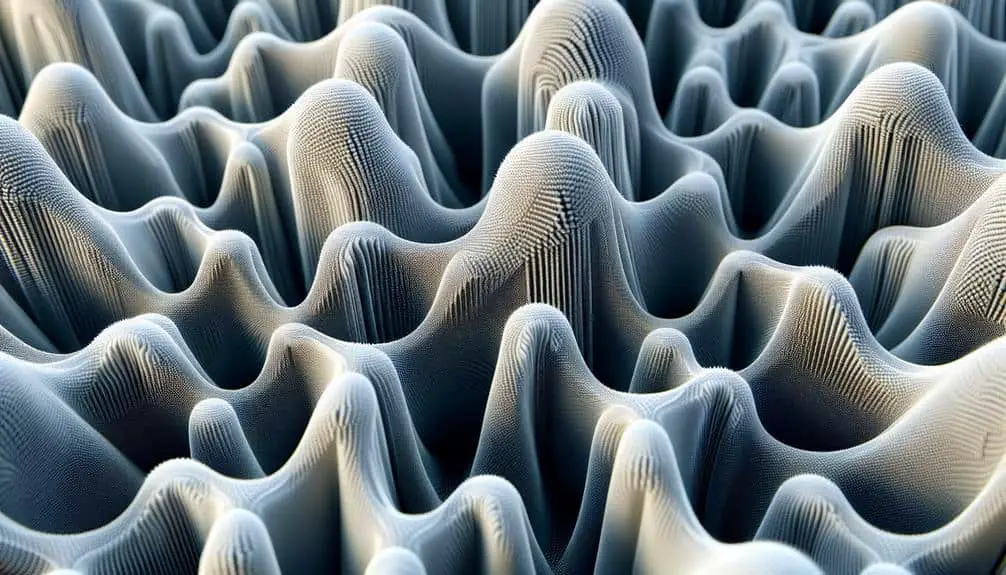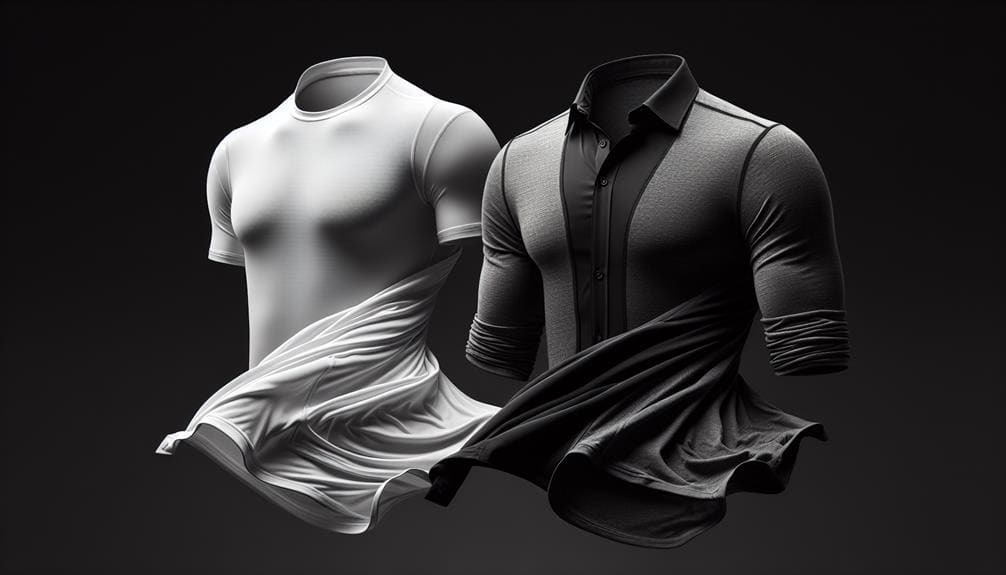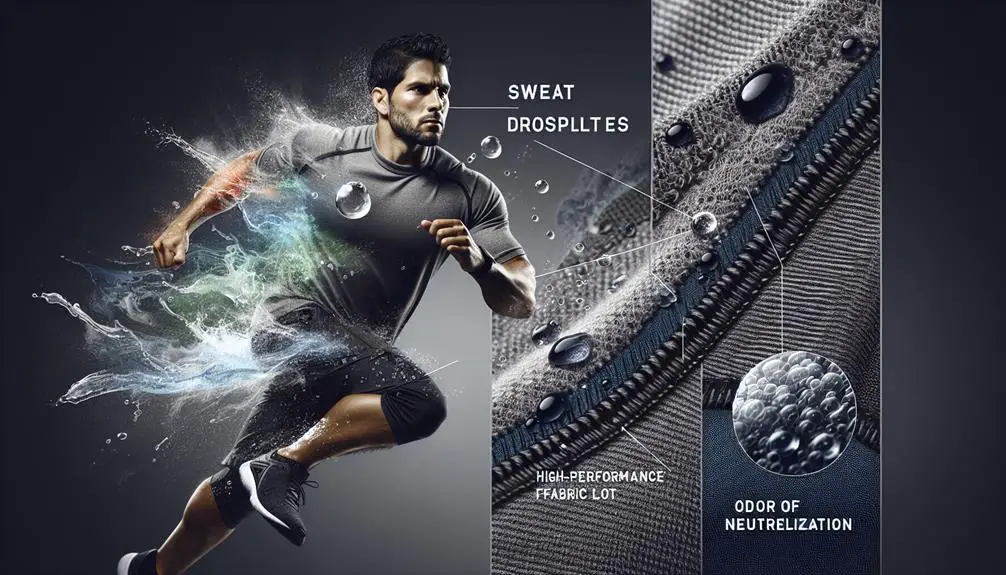Silver ions technology and innovative fabric treatments keep odor-resistant sportswear fresh longer. Bacterial growth on fabrics, fueled by sweat, is disrupted by these technologies. Silver ions penetrate bacteria cells, disrupting their processes. Moisture management in the fabric reduces microbial growth. Anti-odor treatments bind at a molecular level, enhancing durability over washes. Regular washing with gentle detergent maintains effectiveness. Hang-drying prevents damage and guarantees complete dryness. Storing gear in a ventilated area with breathable solutions sustains freshness. The interaction of these factors contributes notably to the longevity of odor resistance in sportswear.
Key Points
- Silver ions technology disrupts bacterial growth on fabrics, ensuring long-lasting odor control.
- Moisture management technologies reduce microbial growth, enhancing odor resistance.
- Advanced fabric treatments inhibit odor-causing bacteria, prolonging freshness.
- Durability of anti-odor treatments prevents bacterial growth over multiple wears.
- Proper maintenance like gentle washing and drying techniques preserves the effectiveness of odor-resistant gear.
The Science of Odor Prevention
To comprehend how odor-resistant sportswear works, it's important to explore the biochemical processes that hinder the growth of odor-causing bacteria on fabrics. Bacterial growth on textiles is primarily fueled by sweat, providing a nutrient-rich environment for microbes to thrive. However, the application of innovative technologies disrupts this cycle through targeted chemical reactions. These chemical reactions involve the interaction of specialized compounds with the bacterial cell membrane, disrupting essential functions and ultimately inhibiting growth.
Silver ions, for example, have been extensively studied for their antimicrobial properties. When incorporated into sportswear fabrics, silver ions undergo controlled release upon contact with sweat. These ions penetrate bacterial cells, interfering with their metabolic processes and structural integrity. This disruption leads to the suppression of bacterial growth, consequently reducing the production of odors associated with microbial metabolism.
Understanding these chemical mechanisms is key to appreciating the efficacy of odor-resistant sportswear. By impeding bacterial growth through targeted chemical reactions, these garments can offer long-lasting freshness and enhanced comfort during physical activities.
Benefits of Silver Ions Technology
Exploring the application of silver ions technology in sportswear fabrics reveals significant advancements in antimicrobial properties for inhibiting bacterial growth and minimizing odor production. Silver nanoparticles, known for their effectiveness in various industries, are integrated into the fabric to combat odor-causing bacteria. The key benefit lies in the mechanism of odor elimination through the release of silver ions. These ions interact with the bacteria on a cellular level, disrupting their basic functions and preventing reproduction, thereby curbing the unpleasant odors associated with sweat.
Research indicates that silver ions technology provides a long-lasting solution for odor control in sportswear. By incorporating this technology, manufacturers offer consumers a garment that stays fresh for extended periods, even during intense physical activities. Moreover, the durability of silver ions on the fabric ensures that the odor-resistant properties remain effective through multiple wash cycles, maintaining the garment's performance over time. Embracing silver ions technology in sportswear signifies a significant stride towards enhancing the functionality and comfort of athletic apparel.
How Moisture Management Impacts Odor Control
Moisture management plays an essential role in influencing the effectiveness of odor control mechanisms in sportswear fabrics. Fabric technology designed for moisture wicking helps in keeping the skin dry by drawing sweat away from the body, creating an unfavorable environment for microbial growth. When moisture is efficiently managed, there's less dampness for odor-causing bacteria to thrive on the fabric. By incorporating advanced fabric technologies like hydrophobic materials or moisture-wicking finishes, sportswear can effectively control odor by reducing the moisture content that bacteria require for proliferation.
Microbial growth, which is the primary cause of odor in sportswear, thrives in damp environments. Moisture management technologies disrupt this growth cycle by minimizing the moisture present on the fabric's surface. By controlling moisture through innovative fabric treatments, the growth of odor-producing bacteria is inhibited, ultimately prolonging the freshness of the sportswear. Understanding the intricate relationship between moisture management and odor control is vital in designing sportswear that remains odor-resistant even during intense physical activities.
Durability of Anti-Odor Treatments
The effectiveness and longevity of odor-resistant treatments in sportswear are directly linked to the durability of the anti-odor treatments applied to the fabric. Odor fighting technology plays an essential role in ensuring long-lasting effectiveness in preventing the growth of odor-causing bacteria on sportswear. The durability of these treatments is vital in maintaining the garment's odor-resistant properties over multiple wears and washes.
To enhance the durability of anti-odor treatments, manufacturers often employ advanced techniques such as binding the odor-fighting agents at a molecular level to the fabric. This guarantees that the treatment remains effective even after numerous wash cycles, providing athletes with long-lasting odor protection during intense physical activities.
Research indicates that the proper application of anti-odor treatments, coupled with high-quality materials, contributes significantly to the longevity of odor resistance in sportswear. Understanding the mechanisms behind these treatments can help consumers make informed decisions when selecting durable and effective odor-resistant sportswear for their athletic needs.
Maintenance Tips for Odor-Resistant Gear
For peak performance and longevity of your odor-resistant gear, regular washing and proper care are crucial to maintain the effectiveness of the anti-odor treatments. When washing your odor-resistant sportswear, opt for a gentle detergent that's free of harsh chemicals and additives. Avoid using fabric softeners as they can diminish the odor-resistant properties of the gear. Additionally, wash your gear in cold water to prevent any damage to the fabric or the anti-odor technology. Hang-dry your gear instead of using the dryer, as excessive heat can also degrade the effectiveness of the odor-resistant treatments.
When it comes to storage solutions, make sure that your odor-resistant gear is completely dry before storing it. Moisture can lead to bacterial growth, which can cause odors to develop. Store your gear in a well-ventilated area to prevent any musty smells from developing. Consider using breathable storage bags or containers to keep your gear fresh and ready for your next workout. By following these washing techniques and storage solutions, you can extend the lifespan of your odor-resistant sportswear and keep it fresh for longer.
Frequently Asked Questions
Can Odor-Resistant Sportswear Be Safely Worn for Multiple Workouts Without Washing?
Like a well-oiled machine, odor-resistant sportswear can endure multiple workouts without washing, provided sweat levels are moderate. The reusability stems from advanced fabric technology, ensuring longevity and effectiveness in maintaining freshness.
How Do Different Types of Fabrics Affect the Effectiveness of Odor-Resistant Treatments?
When considering how fabric composition impacts odor-resistant treatments, moisture-wicking materials like polyester can hinder bacterial growth. Effective ventilation in sportswear allows for quick drying, reducing the environment where odor-causing bacteria thrive, enhancing freshness longevity.
Are There Specific Storage Instructions to Maintain the Odor-Resistance of Sportswear?
For proper storage of odor-resistant sportswear, consider airflow and moisture control. Hang garments to air out after wear and avoid damp environments. This maintenance routine can help preserve the effectiveness of odor prevention treatments.
What Impact Does Sweat Ph Have on the Longevity of Odor-Resistance in Sportswear?
When sweat microbes interact with fabric technology, the pH of the sweat can impact the longevity of odor-resistance in sportswear. Understanding how pH levels affect the efficacy of odor-resistance treatments is essential for maintaining freshness.
Can Odor-Resistant Treatments Be Reapplied to Sportswear After Multiple Washes to Maintain Effectiveness?
When it comes to maintaining the effectiveness of odor-resistant treatments in sportswear, you might wonder about reapplication frequency. Reapplying after multiple washes can help guarantee the longevity of the treatment's efficacy.




